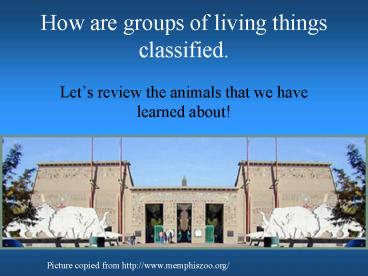How are groups of living things classified' - PowerPoint PPT Presentation
1 / 19
Title:
How are groups of living things classified'
Description:
Common Traits of Amphibians. Have special skin that they absorb moisture through. Cold Blooded ... some amphibians. Student understanding of Amphibians. Their ... – PowerPoint PPT presentation
Number of Views:32
Avg rating:3.0/5.0
Title: How are groups of living things classified'
1
How are groups of living things classified.
- Lets review the animals that we have learned
about!
Picture copied from http//www.memphiszoo.org/
2
Common Traits of Mammals
- Have fur, hair, or wool
- Warm Blooded
- Drink milk from their mothers
- Live birth of their young
- Name some mammals
3
Student understanding of Mammals
- Have fur, hair, or wool
- Warm Blooded
- Drink Mothers milk
- Have live babies
- Name some mammals, dog, cat, cow , horse
4
Common Traits of Reptiles
- Have scales
- Cold Blooded
- Young come from eggs
- 4 types (snakes, crocodilians, lizards, turtles)
5
Student understanding of Reptiles
- Have scales
- Cold Blooded
- Young come from eggs
- 4 types (snakes, crocodilians, lizards, turtles)
6
Common Traits of Fish
- Have scales
- Their blood is cold
- Babies come from eggs
- Breathe through gills
- Live under the water
7
Student understanding of Fish
- Have scales
- Their blood is cold
- Babies come from eggs
- Breathe through gills
- Live under the water
8
Common Traits of Amphibians
- Have special skin that they absorb moisture
through - Cold Blooded
- Young come from eggs
- Name some amphibians
9
Student understanding of Amphibians
- Their skin is special
- Cold Blooded
- Babies come from eggs
- Frogs, salamanders
10
Common Traits of Birds
- Have feathers
- Have wings and can fly
- Warm Blooded
- Young come from eggs
- Have beaks
- Name some birds
11
Student understanding of Birds
- Have feathers
- They can fly
- Their blood is warm
- Babies from eggs
- Have beaks
- Ducks, chickens, eagles
12
Common Traits of Insects
- Six legs
- Three body parts (abdomen, thorax, head)
- Exoskeleton
- Four wings
- Use feelers
- Name some insects
13
Student understanding of Insects
- Six legs
- Three body parts (abdomen, thorax, head)
- Exo?
- Four wings
- They have feelers
- Bees, ants, butterflies
14
Common Traits of Arachnids
- Eight legs
- Two body parts (abdomen, thorax)
- Exoskeleton
- Eight eyes
- Name some spiders
15
Student understanding of Arachnids
- Eight legs
- Two body parts (abdomen, thorax)
- Exo?
- Eight eyes
- Daddy long legs, spider with red on it.
16
Making a student template
- Students will be expected to demonstrate
knowledge illustrating they can compare and
classify animals on the basis of observable
physical characteristics.
17
Lion
Name of the Animal
Animal Family
Mammal
http//www.nationalgeographic.com/animals/
Picture and video from National Geographic
Homepage at http//www.nationalgeographic.com/kids
/creature_feature/0109/lions.html Retrieved on
November 13, 2002.
- Lions have live birth for their young.
- Lions have hair on their bodies.
- Lions are predators in the animal kingdom.
18
- Now we will review center time and we can get
started on our animal projects!
19
- Resources
- Animal Objectives listed are from Plainwell
Community Schools Grade One Science Outcomes - All pictures not otherwise noted are pulled from
Microsoft Clip Art Gallery.































